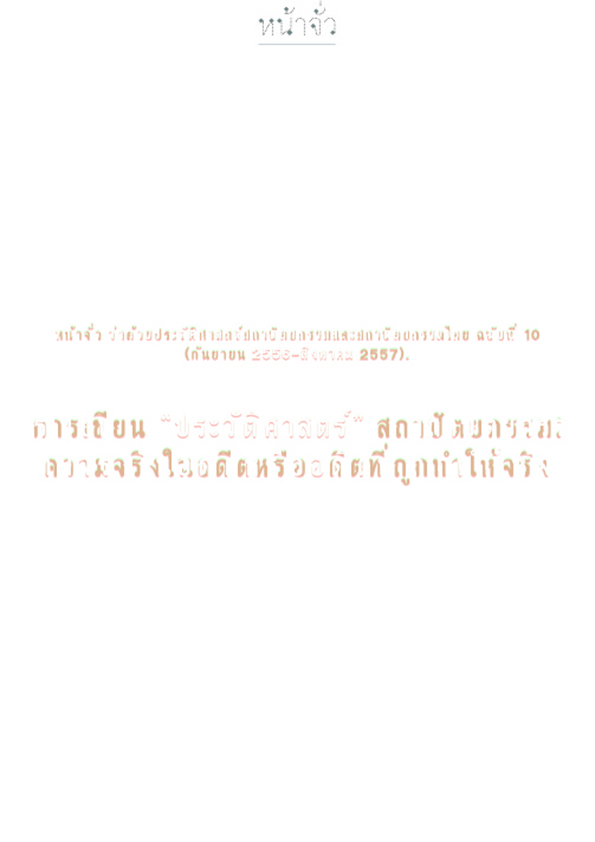วัดเบญจมบพิตร : การแสดงออกซึ่งความเป็นไทยและการเขียนประวัติศาสตร์ของรัฐชาติ Wat Benchama Bophit : A Material Manifestation of the Thai Identity and National Historiography
Main Article Content
Abstract
บทคัดย่อ
งานวิจัยชิ้นนี้ได้ทำการศึกษาวัดเบญจมบพิตรโดยคำนึงถึงบทบาทด้าน 1) การเป็นสื่อแสดงอำนาจรัฐ 2) การแสดงออกถึงอัตลักษณ์อันพึงปรารถนาของชนชั้นปกครองที่ได้ถูกนำไปใช้ในการสร้างเอกลักษณ์ทางวัฒนธรรมแห่งชาติซึ่งรู้จักกันในนามของ “ความเป็นไทย” และ 3) การทำหน้าที่สะท้อนอุดมการณ์ความเป็นรัฐชาติจากชนชั้นนำของประเทศ
อนึ่ง สาระของงานวิจัย ซึ่งตั้งอยู่บนทฤษฎีการศึกษาวัฒนธรรมยุคหลังอาณานิคม ได้ชี้ให้เห็นถึงกรรมวิธีด้านการสื่อสัญลักษณ์ทางสถาปัตยกรรม โดยวัดเบญจมบพิตร ในการสร้างภาพแห่งความเป็นอารยะสำหรับรัฐชาติสมัยใหม่ ตลอดจนการแสดงออกถึงเอกลักษณ์ “ความเป็นไทย” เพื่อใช้ต่อสู้กับการแผ่ขยายอิทธิพลจากมหาอำนาจตะวันตกผ่านลัทธิการล่าอาณานิคม โดยที่การศึกษาดังกล่าวยังได้เปิดเผยและโต้แย้งต่อไปว่า การล่าอาณานิคมในอุษาอาคเนย์นั้นมิได้ถือกำเนิดมาจากการแข่งขันระหว่างมหาอำนาจตะวันตกแต่เพียงอย่างเดียว ทว่ายังเป็นผลมาจากการแย่งชิงผลประโยชน์ระหว่างรัฐต่าง ๆ ในภูมิภาคอีกด้วย ดังนั้น สยามจึงไม่ได้ตกเป็นเหยื่อหรือผู้ถูกกระทำแต่เพียงฝ่ายเดียวดังที่ปรากฏตามคำอธิบายทางประวัติศาสตร์ซึ่งเป็นที่ยอมรับและได้รับการเผยแพร่กันอย่างกว้างขวาง แต่ในความเป็นจริงแล้ว สยามกลับเป็นหนึ่งในผู้ล่าอาณานิคมเช่นกัน
นอกจากนี้ โดยอาศัยการเสวนาเชิงวิพากษ์เกี่ยวกับวาทกรรม “ความเป็นไทย” เนื้อหาทั้งหมดในข้างต้น ยังได้นำเสนอประเด็นสำคัญต่าง ๆ ที่เกี่ยวข้องกับ “ความเป็นชาติ” ผ่านปฏิสัมพันธ์ระหว่าง 1) วัดเบญจมบพิตรในฐานะของสัญลักษณ์แห่ง “สยามอารยะ” หรือสยามสมัยใหม่ และ 2) การเปลี่ยนแปลงความหมายด้านสัญลักษณ์ของวัดเบญจมบพิตรอันเป็นผลสืบเนื่องจากบริบททางสังคมและการเมืองที่แปรเปลี่ยนไป
Abstract
This research presents a critical inquiry on Wat Benchama Bophit in Bangkok with respect to its roles in : 1) functioning as a means of power meditation for the state and ruling authority; 2) signifying the national and cultural identities known as “Thainess” or khwampenthai; and 3) expressing the ideological views of the ruling elites on Thai nationhood.
Informed by the post-colonial theories, the study examines this so-called “Marble Temple” through its politics of representation in creating Siam’s self-image and the Thai identity for a “modernized” nation-state to counter Western expansions. The investigations on the symbolism and iconography of the temple further reveal that the practice of colonization in Southeast Asia did not exclusively come from the West, but took place among states within the region as well. Siam in the 19th century was a regional colonial power, not a victim of Western aggressions as widely publicized by the conventional historiography.
By utilizing khwampenthai as a mode of problematization, the upcoming discussions address several important issues related to the subject of Thai nationhood, and evolve around the themes of : 1) Wat Benchama Bophit as a material embodiment of the “civilized” Siam; and 2) the transformation of the temple’s meanings as a result of the country’s changing socio-political contexts.


